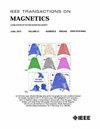Coupled Electromagnetic–Fluid–Thermal Analysis in Large Scale Water–Hydrogen Hydrogen-Cooled Generator-Condenser Under Different Operations
IF 2.1
3区 工程技术
Q3 ENGINEERING, ELECTRICAL & ELECTRONIC
引用次数: 0
Abstract
The synchronous generator running under the condenser condition can enhance the dynamic reactive power compensation capability of the new power system. However, the thermal of the generator is an important factor limiting its reactive power compensation ability. This article takes a 350 MW/300 Mvar water-hydrogen-hydrogen cooled generator-condenser as an example. Based on the coupled model of electromagnetic-fluid-thermal, the electromagnetic performance and stator temperature field under multiple working conditions are studied. First, 2-D electromagnetic field-circuit coupling model is built, and the magnetic density under generator-condenser condition is studied; additionally, the loss is used as the boundary condition to work out the thermal field. Second, through the iterative of the global ventilation network of the generator-condenser, the flow and pressure that suit the accuracy requirements are taken as the boundary conditions of the fluid field. Finally, by establishing 3-D fluid-solid coupled model of the stator with full axial half teeth and half slots, the thermal field of the winding, insulation, and water under the generator-condenser condition is analyzed with the finite volume method. This article provides useful references for the design and retrofit of the generator-condenser.求助全文
约1分钟内获得全文
求助全文
来源期刊

IEEE Transactions on Magnetics
工程技术-工程:电子与电气
CiteScore
4.00
自引率
14.30%
发文量
565
审稿时长
4.1 months
期刊介绍:
Science and technology related to the basic physics and engineering of magnetism, magnetic materials, applied magnetics, magnetic devices, and magnetic data storage. The IEEE Transactions on Magnetics publishes scholarly articles of archival value as well as tutorial expositions and critical reviews of classical subjects and topics of current interest.
 求助内容:
求助内容: 应助结果提醒方式:
应助结果提醒方式:


